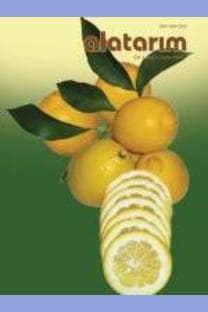Bitki renk maddelerinin (pigmentler) oluşum ve değişim fizyolojisi
bitki pigmentleri, pigmentler, fotosentez, bitki fizyolojisi
The formation and changing physiology of plant colour pigments
plant pigments, pigments, photosynthesis, plant physiology,
___
- Alkema, J., Seager, S.L., 1982. The Chemical Pigments of Plants. Journal of Chemical Education, Vol.59, No.3.
- Almeida, J., Carpenter, R., Robbins, T.P., Martin, C., Coen, E.S., 2008. Genetic Intereactions Underlying Flower Color Patterns in Antirrhinum majus L. Genes & Dev. 3: 1758-1767.
- Andris, H., Crisosto, C.H., 1996. Reflective Materials Enhance ‘Fuji’ Apple Color. California Agriculture, Vol.50, No.5.
- Anonim, 2008a. Renk Veren Moleküller: Pigmentler. htpp://images.google.com.tr/imgres?imgurl (24.03.2008).
- Anonim,2008b. Flavonoid Biosynthesis in Bilberry (Vaccinium myrtillus L.). htpp://hercules.oulu.fi/isbn9514271599html/210.html (21.03.2008).
- Anonim,2008c. Color Change in Leaves.htpp://www.juliantrubin.com/encyclopedia/botany/leaves_color_change_files/300px- (24.03.2008).
- Anonim, 2008d. The Process of Leaf Color Change. htpp://www.ces.ncsu.edu/nreos/forest/topics/leafco~1.html (16.04.2008).
- Anonim, 2008e. Molecules of Color: Anthocyanin. htpp://images.google.com.tr/imgres?imgurl (24.03.2008).
- Anonim, 2008f. Why Do Leaves Change Colour in Autumn? htpp://www.cornwallwildlife.org.uk/educate/kids/leaves.htm (10.03.2008).
- Anonim, 2008g. The Breakdown of Chlorophyll. htpp://www.botany.unibe.ch/nutr/research/Project/chlorophyll.php (14.03.2008).
- Anonim, 2008h. Meyve ve Sebze Atıklarından Elde Edilen Doğal Renk Maddelerinin Üretimi ve Gıda Sanayisinde Kullanım Alanları. htpp://foodwaste-fruit.tripod.com/id3.html (16.04.2008).
- Anonim, 2008j. Fotosentetik Organlar ve Pigmentler. ziraat.mku.edu.tr/tarla/personel_veri/memin/fotosentez.ppt (12.04.2008).
- Anonim, 2008k. Photosyntetic Pigments. www. ucmp.berkeley.edu/glossary/gloss3/pigments.html (21.03.2008).
- Asen, S., Stewart, R.N., Norris, K.H., 1972. Phytochemistry, Vol. 11, No. 3, pp. 1139-1144.
- Bordignon-Luiz, M.T., Gauche, C., Gris, E.F., Falcao, L.D., 2007. Colour Stability of Anthocyanins from İsabel Grapes (Vitis labrusca L.) in Model Systems. LWT 40, 594-599.
- Bramley, P.M., 2002. Regulation of Carotenoid Formation During Tomato Fruit Ripening and Development. Journal of Experimental Botany, Vol. 53, No. 377, pp. 2107-2113.
- Brouillard, R., Wigand, M.C., Cheminat, A., 1990. Loss of Colour, a Prerequisite to Plant Pigmentation by Flavonoids. Phtochemistry, Vol.29, No. 11, pp. 3457-3460.
- Chen, LJ., Hrazdina, G., 1981. Structural Aspects of Anthocyanin Complex Formation and Its Role in Plant Color. Vol. 20, No. 2, pp. 297-303.
- Duysen, M.E., Freeman, T.P., 1976. Promotion of Plastid Pigment Accumulation in Stressed Wheat Leaf Sections by Hormone Treatment. American Journal of Botany, 63 (8):1134-1139.
- Fang, Z., Bouwkamp, J.B., Solomos, T., 1998. Chloropyllase Activities and Chlorophyll Degradation during Senescence in Non-Yellowing Mutant and Wild Type of Phaseolus vulgaris L. Journal of Experimental Botany, Vol. 49, No. 320, pp. 503-510.
- Hornero-Marqez, D., Guevera, R.G., Min, M.I., 2000. Carotenoid Biosyntesis Changes in Five Red Pepper (Capsicum annum L.) Cultivars During Ripening. Cultivar Selection for Breeding. J. Agric. Food Chemisty, 48. 3857-3864.
- Hörtensteiner, S., 2006. Chlorophyll Degradation during Senescence. Annu. Rev. Plant Bilogy,57: 55-57.
- Javane, M.T., 1997. Enzymic Degradation of Chlorophyll in Cavendish Bananas: In Vitro Evidence for Two Independent Degradative Pathways. Plant Physiology and Biochemistry, Vol. 35, No. 141, pp. 837-846.
- Jun Li, X., Hou, JH., Zhang, GL., Liu, RS., Yang, Y.G., Hu, YX., Lin, JX., 2004. Comparison of Anthocyanin Accumulation and Morpho-Anatomical Features in Apple Skin during Color Formation at Two Habitats. Scientia Horticulturae, 99, 41-53.
- Karaaltın, S., Sezal, M.Ş., Yılmaz, M.F., 2005. Pigmentlerin Sentezi, Biyokimyası ve Çeşitli Bitki Organlarının Rengi. Türkiye VI. Tarla Bitkileri Kongresi, Cilt 1. 369-374, 5-9 Eylül, Antalya.
- Kato, M., Shimizu, S., 1985. Chlorophyll Metabolism in Higher Plants VI. Involvement of Peroxidase in Chlorophyll Degradation. Plant and Cell Physiology, Vol. 26, No. 7, 1291-1301.
- Lee, D.W., Gould, K.S., 2002. Why Leaves Turn Red. American Scientist, Vol. 90.
- Moser, D., Matile, P., 1997. Chlorophyll Breakdown in Ripening Fruits of Capsicum annum L.Journal of Plant Biology, Vol. 150, No. 6, pp. 759-761.
- Onozaki, T., Mato, M., Shibata, M., Ikeda, H., 1999. Differences in Flower Color and Pigment Composition among White Carnation (Dianthus caryophyllus L.) Cultivars. Scientia Horticulturae, 82, 103-111.
- Pan, H.H., Shu,, Z.H., 2007. Temperature Affects Color and Quality Characteristics of ‘Pink’Wax Apple Fruit Discs. Scientia Horticulturae, 112, 290-296.
- Ratkin, A.V., Evdokimova, L.I., Zhanaeva, T.A., 2003. Study on Degradation of Flavonols in Mutants of Poppy Papaver somniforum L. Biology Bulletin, Vol. 30, No. 5, pp. 458-463.
- Ronen, G., Carmel-Goren, L., Zamir, D., Hirschberg, J., 2000. An Alternative Pathway to β-Carotene Formation in Plant Chromoplasts Discovered by Map-based Cloning of Beta and Old-gold Color Mutations in Tomato. PNAS, Vol. 97, No. 20, 11102-11107.
- Rüdiger, W., 1997. Chlorophyll Metabolism: From Outer Space Down to the Molecular Level. Phytochemistry, Vol.46, No. 7, pp. 1151-1167.
- Vicentini, F., Hortensteiner, S., Schellenberg, M., Thomas, H., Matile, P., 1995. Chlorophyll Breakdown in Senescent Leaves: Identification of the Biochemical Lesion in a Stay-Green Genotype of Festuca pratensis Huds. New Phytologist, Vol. 129, No. 2, pp. 247-252.
- Weemaes, C.A., Ooms, V., Van Loey, A.N., Hendrikx, M.E., 1999. Kinetics of Chlorophyll Degradation and Color Loss in Heated Broccoli Juice. J. Agric. Food Chem., 47 (6), pp. 2404-2409.
- Willson, M.F., Whelan, C.J., 1990. The Evolution of Fruit Color in Fleshy-Fruited Plants. The American Naturalist, Vol. 136, No. 6.
- ISSN: 1304-2653
- Başlangıç: 2015
- Yayıncı: Alata Bahçe Kültürleri Araştırma Enstitüsü
Ahmet Erhan ÖZDEMİR, Elif Ertürk ÇANDIR, Mustafa KAPLANKIRAN, Turan Hakan DEMİRKESER, CELİL TOPLU, ERCAN YILDIZ
Citrus cinsi içerisinde yer alan bazı önemli türlerin genetik orijinleri
AYDIN UZUN, TURGUT YEŞİLOĞLU, Yıldız Aka KAÇAR, Önder TUZCU, OSMAN GÜLŞEN
Mersin ve Adana ili kayısı bahçelerinde bulunan Trips (Thysanoptera) türleri üzerinde araştırmalar
Moleküler markör tekniklerinin bağcılıkta kullanımı
Ali SABIR, SEMİH TANGOLAR, Saadet BÜYÜKALACA
Begonia semperflorens'in direk organogenesis yöntemiyle rejenerasyonu
N. Yeşim Yalçın MENDİ, Esra KOCAMAN, Ceren ÜNEK, Selay ELDOĞAN, Pembe ÇÜRÜK, Günsu GENCEL, SEDAT SERÇE
Bitki renk maddelerinin (pigmentler) oluşum ve değişim fizyolojisi
Halil KARAKURT, RAFET ASLANTAŞ
